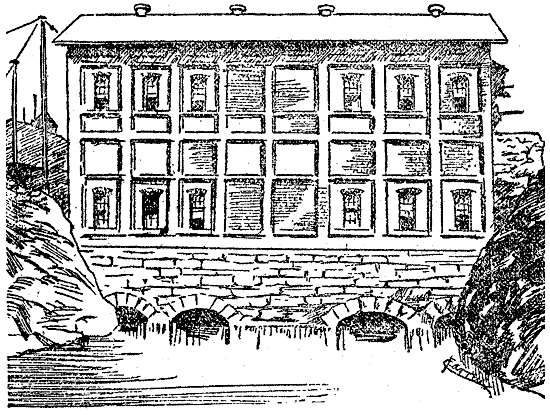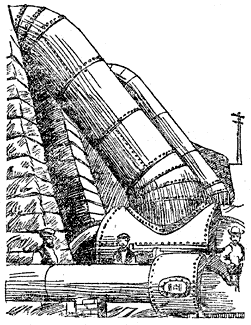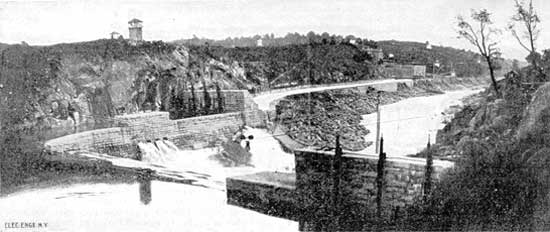[Trade Journal]
Publication: The Electrical Engineer
New York, NY, United States
vol. XX, no. 378, p. 115, col. 1-2
INAUGURATION OF THE FOLSOM-SACRAMENTO
3-PHASE POWER TRANSMISSION PLANT
On July 14 current was transmitted for the first time over the new 3-phase transmission plant between Folsom and Sacramento, Cal., and has continued in successful operation from the start. In our issue of February 13, 1895, our special correspondent, Mr. H. Guy, gave the first details of this interesting installation which constitutes one of the largest enterprises of its kind in the country and which cannot fail to have a marked influence on the future of power transmission in California.
The power is derived from the water of the American River confined by a dam 650 feet long, 24 feet wide at the top and 87 feet wide at the bottom and 89 feet high at the highest point. The storage basin thus formed is 3 1/2 miles long and has a capacity of 13,000,000 cubic yards. A canal runs from the dam along the side of the river down to the power plant and mill sites, opposite Folsom. This canal is 50 feet wide and 8 feet deep, carrying 85,000 cubic feet of water per minute. Its walls are built in large part of solid masonry, the work having been done largely by prison labor under a contract with the State.
The river has a fall of 82 feet from dam to power house, and of this fall seventy feet can be utilized for power, producing when fully utilized 10,000 horse-power.
| |||
| Fig. 1. - Dam and Canal of the Folsom-Sacramento Electric Transmission Plant, Folsom, Cal. |
The plant now installed has a capacity for generating 4,000 H. P., and two of the four generators necessary to produce this are now placed, and two more are on the ground ready for setting on the foundations. Our engraving Fig. 2 shows the power house of the Sacramento Electric Power and Light Co., which covers a cut in the solid rock 60 feet deep, 100 feet wide and 15 feet long.
 |
| Fig. 2. - the Power House at Folsom. |
The discharge of the water from the canal into the power station is regulated by four gates, so that any one of the four 1,000 horse power generators can be used independently of the others; Fig. 3 shows the penstocks and turbines. These latter of the McCormick type are of 1,200 H. P. capacity each and run at 350 R. P. M. under a head of 55 feet. They were built by the S. Morgan Smith Works, of York, Pa., under contract with the Pelton Water Wheel Co. of San Francisco.
The dynamo room is arranged for four 1,000 H. P. 3-phase generators built by the General Electric Co., coupled direct to the turbine shafts. These machines weigh 40 tons each and are the largest 3-phase machines built thus far. They deliver current to step-up transformers which raise the potential to 11,000 volts on the line.
 |
| Fig. 3. - Pennstock and Turbines. |
The double pole line from Folsom to Sacramento is 22 1/2 miles long. The poles are of red cedar, 40 feet long, 16 inches in diameter at the butt; they are set 105 feet apart and carry five cross arms, 4 x 4 inches by 7 feet long, placed 16 inches one above the other. At present the three top arms each carry two No. 1 bare copper wire, and the 3-phase current is delivered at Sacramento to step-down transformers. The transformed current is led to three 3-phase motors of 300 H. P. capacity each which drive street railway generators and arc light machines.
An interesting feature of the installation is the telephone line, which connects the power house at Folsom with the station at Sacramento. The liability to induction at first deterred the managers of the enterprise from stringing the telephone wires on the same poles as the power transmission wires, but Mr. Chas. E. Severance and Mr. V. J. Mayo, E. E., of the California Telephone and Construction Co., of San Jose, Cal., the agents of the Columbia Telephone Co., in California, undertook the work. The telephone conductors are placed on the lowest pole arm and 40 inches from the nearest power conductor. By a skillful system of transposing the wires no trouble whatever is experienced from induction, and the articulation of the Columbia telephones over the distance of 22 1/2 miles is perfectly clear. Considering the length of the line and the great proximity of the disturbing wires the feat accomplished is well worth of notice.

